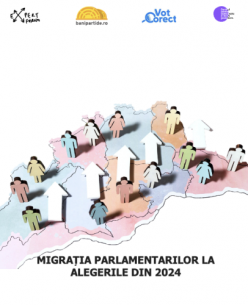Report on “Migration of parliamentarians in the 2024 elections”

Most candidates in the parliamentary elections labeled as party-switchers are on the lists of the Alliance for the Union of Romanians (AUR) and S.O.S. Romania, according to a report published Friday by Expert Forum. At the opposite end, the fewest party-switchers are found on the lists of the Save Romania Union (USR).
Expert Forum and the Center for Democracy and Good Governance published on Friday, November 8, the report on “Migration of parliamentarians in the 2024 elections”, which analyzes the electoral process of the candidates.
“We tried to see, first of all, how much the candidates change, how much the political class renews, if they are the same candidates as in the last elections, if they belong to the same parties. Practically, one of the important questions was whether he walks from one party to another”, explained Septimius Parvu, expert in elections and financing of political parties and Expert Forum representative, for Digi24.ro.
The analysis is limited to the parties that have the greatest chances of entering Parliament: AUR, PNL, PSD, SOS Romania, UDMR and USR.
71.33% of the candidates proposed by the parties in the parliamentary elections on December 1 are in their first candidacy. Around 18% of those running in 2024 have run for another round of parliamentary elections in the past (2020 or 2016), while 9% are running for the third time, according to the quoted source.
“The classic parties (n.r. PNL, PSD, UDMR) have a lower rate of both party-switching and new candidates. There is a lower rate, we don’t see the same thing as in AUR, SOS, which practically gathered candidates from many parties”, explained the Expert Forum representative.
AUR and SOS have the highest number of candidates labeled as party-switchers, with 11% of each party’s electoral lists made up of such candidates, according to Septimius Parvu. “You want many candidates because it’s a show of strength. Having many candidates signals that you’re a party that could matter. For a new party—like we saw with AUR in the last elections—you start small and need to gather candidates from all around. Many who joined come from parties with a populist or sovereigntist message, or from parties that have lost traction,” Parvu explained.
Notably, SOS Romania’s founder, Diana Sosoaca, initially won her Senate seat on AUR’s list, only to leave in 2021 and establish SOS. “AUR also appears to have seen internal splits and disagreements, which led to many new candidates. Some members left AUR disillusioned after realizing it wasn’t as expected. Many migrated from AUR to SOS Romania. In sovereigntist parties, we see the highest rate of party-switching,” the expert added.
Among traditional parties, the highest percentage of party-switchers is found on the lists of the Social Democratic Party (6.57%). Most of these party-switchers, on average, come from smaller parties that failed to pass the electoral threshold in previous elections, such as PMP, ALDE, or PRO Romania, according to the cited report. However, traditional parties also contribute party-switchers. Nearly 2% of AUR’s candidates come from the National Liberal Party (PNL), while another 2% of former AUR candidates now appear on SOS lists.
Another conclusion from the Expert Forum report is that parties like USR, AUR, and SOS are fielding more “new” candidates compared to traditional parties such as PNL, PSD, and UDMR. However, these “new” candidates are often placed at the bottom of the lists, giving them minimal chances of securing seats as deputies or senators.
“These findings suggest that parties prefer candidates with experience and the electoral capital they bring over newcomers. However, between a loyal candidate and a party-switcher, loyalty is clearly prioritized by all parties,” the report adds.
(Photo:https://expertforum.ro/)
